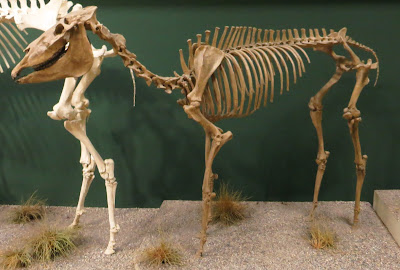Belongs within: Equinae.
Hipparion is a diverse genus of three-toed horses known from the Miocene to the Pleistocene of Eurasia, Africa and North America.
Characters (from Churcher & Richardson 1978): Facial region relatively short and deep; preorbital fossae present or absent; sagittal crest low; bony auditory meatus long and directed dorsolaterally; basicranial region usually with prominent longitudinal crest; occiput with deep fossae above occipital condyles for attachment of nuchal musculature. Coronoid process of dentary high; ascending ramus vertical. Incisors large, cement filled; infundibula typically present on upper and lower I1 and I2; in I3 infundibulum closed or partly closed. Canines usually present in both sexes, possibly dimorphic. Cheek teeth moderately to very hypsodont, slightly bowed, prismatic. Upper cheek teeth with isolated, more or less elongate protocones, almost always with many plis in fossettes. Lower cheek teeth with well-developed double loop, metaflexid with subequal arms and deep median valley; M3 usually with tripartite talonid; well-developed ectostylid in milk lower cheek teeth of all forms where known and in permanent lower cheek teeth of more derived forms. Limbs with angled joints, ulna complete. Metapodials moderately to very elongate; metapodials III with traces of II and IV contacts along shafts; metapodials II and IV variably developed, apparently without reduction in size through time; vestigial metacarpal V present. Digits II, III and IV functional but II and IV shorter and thinner than III. Terminal phalanges (ungules) cut by deep median slit.
<==Hipparion de Christol 1832 F99 (see below for synonymy)
|--H. sitifense Pomel 1897 [=H. sitifensis] CR78
| |--H. s. sitifense CR78
| `--H. s. gromovae Villalta & Crusafont 1957 CR78
|--H. turkanense Hooijer & Maglio 1973 CR78
`--+--H. primigenium (von Meyer 1829) [=Equus primigenius; incl. H. gracile] CR78
`--+--+--H. baardi Boné & Singer 1965 [=H. (Hipparion) albertense baardi] CR78
| `--H. namaquense (Haughton 1932) [=Notohipparion namaquense] CR78
`--+--H. afarense Eisenmann 1976 CR78
`--H. libycum Pomel 1897 (see below for synonymy) CR78
|--H. l. libycum CR78
|--H. l. ethiopicum (Joleaud 1933) [=Libyhipparion ethiopicum] CR78
`--H. l. steytleri van Hoepen 1930 [=Libyhipparion steytleri, Stylohipparion steytleri] CR78
Hipparion incertae sedis:
H. africanum Arambourg 1959 F99
H. antelopinum Falconer & Cautley 1847 F99
H. anthonyi D07
H. brachypus Hensel 1862 F99
H. campbelli Bernor 1985 F99
H. catalaunicum Pirlot 1956 F99
H. chiai DW04
H. coelophyes DW04
H. concudense D07
H. dermatorhinum Sefve 1927 F99
H. dongxiangense DW04
H. elegans Gromova 1952 F99
H. fossatum Sefve 1927 F99
H. garedzicum Gabuniya 1959 F99
H. gettyi Bernor 1985 F99
H. giganteum Gromova 1952 F99
H. hippidiodus Sefve 1927 [incl. H. platygenys Gromova 1952] F99
H. houfenense DW04
H. huangheense D07
H. licenti Qiu, Huang & Guo 1987 F99
H. macedonicum Koufos 1984 F99
H. matthewi Abel 1926 F99
H. mediterraneum (Roth & Wagner 1855) F99
H. microtaton Nikolov 1971 F99
H. mogoicum Zhegallo 1978 F99
H. mohavense D07
H. molayanense Zouhri 1992 F99
H. moldavicum Gromova 1952 F99
H. nesebricum Bakalov & Nikolov 1962 F99
H. nicosi Bernor & Tobien 1989 F99
H. parvum DW04
H. periafricanum Villalta & Crusafont 1957 F99
H. platystyle D07
H. plocodus Sefve 1927 F99
H. praegiganteum Tarabukin 1967 F99
H. presulcatum Nikolov 1971 F99
H. proboscideum Studer 1911 F99
H. prostylum Gervais 1849 F99
H. sarmaticum Lungu 1973 F99
H. schlosseri Antonius 1919 [incl. Hemihipparion dietrichi Wehrli 1941, Hi. dietrichi] F99
H. shirleyi MacFadden 1984 F99
H. sinense DW04
H. tchicoicum Ivanjev 1966 F99
H. tudorovense Gabuniya 1959 F99
H. urmiense Gabuniya 1959 F99
H. verae Gabuniya 1979 [=H. gromovae Gabuniya 1959 non Villalta & Crusafont 1957] F99
H. weihoense Liu, Li & Zhai 1978 F99
Hipparion de Christol 1832 F99 [incl. Eurygnathohippus van Hoepen 1930 CR78, Libyhipparion Joleaud 1933 CR78, Notohipparion Haughton 1932 CR78, Stylohipparion van Hoeppen 1932 CR78]
Hipparion libycum Pomel 1897 [=H. (Stylohipparion) libycum; incl. H. albertensis Hopwood 1926 (n. d.), H. albertense, Stylohipparion albertense, H. ambiguum Pomel 1897, Eurygnathohippus cornelianus van Hoepen 1930, Stylohipparion hipkini van Hoepen 1932, Hipparion massoesylium Pomel 1897, H. (Hipparion) albertense serengetense Boné & Singer 1965] CR78
*Type species of generic name indicated
REFERENCES
[CR78] Churcher, C. S., & M. L. Richardson. 1978. Equidae. In: Maglio, V. J., & H. B. S. Cooke (eds) Evolution of African Mammals pp. 379–422. Harvard University Press: Cambridge (Massachusetts).
[DW04] Deng T., Wang X., Ni X. & Liu L. 2004. Sequence of the Cenozoic mammalian faunas of the Linxia Basin in Gansu, China. Acta Geologica Sinica (English Edition) 78 (1): 8–14.
[D07] Dixon, D. 2007. The Complete Illustrated Encyclopedia of Dinosaurs & Prehistoric Creatures. Hermes House: London.
[F99] Forsten, A. 1999. Snout proportions in some Eurasian hipparions (Mammalia, Equidae): taxonomic and functional implications. Geodiversitas 21 (2): 255–278.








